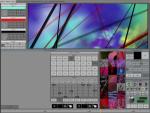Live video mixing / performance is one of the relatively new genres
brought about by a generation of tools that offer access to the
functionality inherent in the current generation of computer hardware.
Although Touch Designer fits in the area of VJ software, it is more
aptly described as "media development artware" because
it incorporates a visual programming IDE (Integrated Development
Environment), 3d / 2d amination application, and the ability to
web-embed visual synths etc. Designer is much more of an integrated
suite of tools than an application, per se, which makes it a little
hard to classify.
 Designer works
in a signal-flow manner, like MAX, PD, Reaktor, VVVV, and Keyworx
(to some extent). Information comes from the input devices, such
as audio, video, MIDI, and whatever you can write code for in order
to get Designer to hear. That information is processed and acted
upon through Channel Operators (that generate or process signals),
and applied to Object Operators (which usually refer to visual elements).
All of these can generate their own signals and pass them on to
other operators or generate their own outputs. Through the development
environment, users can program their own interfaces as well. In
short, Designer is a real-time media design, programming, and performance
tool that is extremely flexible and powerful. Designer works
in a signal-flow manner, like MAX, PD, Reaktor, VVVV, and Keyworx
(to some extent). Information comes from the input devices, such
as audio, video, MIDI, and whatever you can write code for in order
to get Designer to hear. That information is processed and acted
upon through Channel Operators (that generate or process signals),
and applied to Object Operators (which usually refer to visual elements).
All of these can generate their own signals and pass them on to
other operators or generate their own outputs. Through the development
environment, users can program their own interfaces as well. In
short, Designer is a real-time media design, programming, and performance
tool that is extremely flexible and powerful.
In
addition to the real-time media production environment, Designer
also provides a basic set of 2D and 3D modeling tools that are sufficient
for most Designer tasks. For anyone wishing to bring in their own
models, Designer integrates seamlessly with Houdini, and imports
Renderman format files. From the internal formats, as well as imported
files, effects like inverse kinematics, animated textures and others
can be applied to 3D models for live Touch performances (I use Touch
to refer to the general visual synth platform, and Designer for
the development tool).
In performance,
Touch offers a lot of features for the visual designer. Touch synths
can run on dual monitor systems, allowing the operator to manipulate
the visuals on one screen while projecting the other (most likely
sent to video distribution amplifiers etc). Touch synths can also
communicate over IP networks, meaning that multiple cameras can
operate on the same synth, or numerous synths can operate from the
same signal. However, because of latency times in the network, complete
frame-to-frame synchronization isn't really possible, although a
large-scale Derivative Touch net performance is technically feasible.
Within three
months, I was able to get going at a good level of expertise. I
connected a MIDI device to some channel operators, used a particle
system, and produced some interesting effects. This also told me
how deeply I could potentially dive into Designer, and that three
months would not be enough to really sharpen my skills on this platform.
The extensibility
of Touch is considerable: for example, ATR (Kyoto) artist Rod Berry
has integrated AR Toolkit code with Touch to create an augmented
reality visual synthesizer using this particular suite of tools.
In Rod's synth, one might see a card with an icon printed on it,
and above it, for example, a fan. Take another card with a picture
of a letter on it, place it next to the first one, and a mailbox
with letters appears, with the letters being blown around by the
fan. Of course, this is a logical extreme for the tool, and only
illustrates its potentials.
In more mundane
applications, bands like Rush and Plastikman make use of Derivative
Touch in concert to create visuals for their various performances,
and Prada used it for ambient visuals in its Tokyo showcase building.
Derivative Touch Designer supports a range of applications, from
sound and data visualization to nothing short of a development kit,
if someone were inclined to push it this way..
I was impressed
with the level of attention that Derivative places in their product,
and the listserv offers incredibly good support for the product.
The documentation (offered online) is a bit of a work-in-progress,
but far more comprehensive today than when I first saw Derivative
Touch in 2003-4. Any questions about undocumented features are answered
very quickly, and seem to be integrated into the manual at time
of answer. At $ 1,199, derivative offers a lot, but you obviously
have to be serious about using if you invest that much.
Trying to write
a review of Derivative Touch Designer is like condensing an operator's
manual for a 747 into a pamphlet. It's one of the most extensive
live visual performance packages that I've seen and, as mentioned
before, can even act as part of a live new media performance development
kit. One may be a bit overwhelmed by its breadth of features, and
its fairly unique interface paradigm. However, once one gets used
to it, the Designer environment becomes much more intuitive, and
delivers a lot of power. For what it does, Derivative Touch Designer
is an amazing tool.
|

